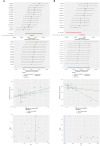Gut microbiota and oral cavity cancer: a two-sample bidirectional Mendelian randomization study
- PMID: 38884080
- PMCID: PMC11177610
- DOI: 10.3389/fonc.2024.1389678
Gut microbiota and oral cavity cancer: a two-sample bidirectional Mendelian randomization study
Abstract
This study employs a two-sample bidirectional Mendelian randomization (MR) approach to systematically evaluate the causal relationship between gut microbiota and oral cavity cancer (OCC).
Objective: To address the challenge in establishing the causal relationship between gut microbiota and OCC, we applied a systematic MR analysis.
Methods: Utilizing GWAS data from the MiBioGen consortium (18,340 individuals) and UK Biobank (n = 264,137), we selected instrumental variables and employed MR-Egger, weighted median, IVW, and weighted mode analyses. Heterogeneity and pleiotropy were assessed using Cochran's Q test and MR-Egger intercept test.
Results: Our findings indicate, at the order level, Bacteroidales (OR = 0.9990, 95% CI = 0.9980-1.0000, P = 0.046), Burkholderiales (OR = 1.0009, 95% CI = 1.0001-1.0018, P = 0.033), and Victivallales (OR = 0.9979, 95% CI = 0.9962-0.9995, P = 0.037) exhibit causality on OCC in the Weighted median, IVW, and MR-Egger analyses, respectively. At the family level, Alcaligenaceae (OR = 1.0012, 95% CI = 1.0004-1.0019, P = 0.002) and Clostridiaceae1 (OR = 0.9970, 95% CI = 0.9948-0.9992, P = 0.027) show causality on OCC in IVW and MR-Egger analyses. At the genus level, Clostridiumsensustricto1 (IVW, OR = 0.9987, 95% CI = 0.9980-0.9995, P = 0.001; MR-Egger, OR = 0.9978, 95% CI = 0.9962-0.9995, P = 0.035), Desulfovibrio (IVW, OR = 1.0008, 95% CI = 1.0001-1.0015, P = 0.016), Eggerthella (IVW, OR = 0.9995, 95% CI = 0.9990-1.0000, P = 0.048), Eubacterium fissicatena group (IVW, OR = 1.0005, 95% CI = 1.0000-1.0009, P = 0.032), and Holdemanella (IVW, OR = 0.9994, 95% CI = 0.9989-0.9999, P = 0.018) are implicated in causing OCC in related analyses.
Conclusion: Our study identifies Burkholderiales order, Alcaligenaceae family, Desulfovibrio genus, and Eubacterium fissicatena group as causally increasing OCC risk. In contrast, Bacteroidales order, Victivallales order, Clostridiaceae1 family, Clostridiumsensustricto1 genus, Eggerthella genus, and Holdemanella genus are causally associated with a decreased OCC risk. However, further investigations are essential to delineate an optimal gut microbiota composition and unravel the underlying mechanisms of specific bacterial taxa in OCC pathophysiology.
Keywords: GWAS; Mendelian randomization; causality; gut microbiota; oral cavity cancer.
Copyright © 2024 Sun, Bai, Hao, Jiang and Chen.
Conflict of interest statement
The authors declare that the research was conducted in the absence of any commercial or financial relationships that could be construed as a potential conflict of interest.
Figures







Similar articles
-
Gut microbiota and type 1 diabetes: a two-sample bidirectional Mendelian randomization study.Front Cell Infect Microbiol. 2023 May 29;13:1163898. doi: 10.3389/fcimb.2023.1163898. eCollection 2023. Front Cell Infect Microbiol. 2023. PMID: 37313342 Free PMC article.
-
Causal relationship between gut microbiota with subcutaneous and visceral adipose tissue: a bidirectional two-sample Mendelian Randomization study.Front Microbiol. 2023 Oct 31;14:1285982. doi: 10.3389/fmicb.2023.1285982. eCollection 2023. Front Microbiol. 2023. PMID: 38029216 Free PMC article.
-
Uncovering a causal connection between the Lachnoclostridium genus in fecal microbiota and non-alcoholic fatty liver disease: a two-sample Mendelian randomization analysis.Front Microbiol. 2023 Dec 12;14:1276790. doi: 10.3389/fmicb.2023.1276790. eCollection 2023. Front Microbiol. 2023. PMID: 38192292 Free PMC article.
-
Causal associations between gut microbiota and premature rupture of membranes: a two-sample Mendelian randomization study.Front Immunol. 2024 Sep 2;15:1440232. doi: 10.3389/fimmu.2024.1440232. eCollection 2024. Front Immunol. 2024. PMID: 39286243 Free PMC article.
-
Genetic liability of gut microbiota for idiopathic pulmonary fibrosis and lung function: a two-sample Mendelian randomization study.Front Cell Infect Microbiol. 2024 May 22;14:1348685. doi: 10.3389/fcimb.2024.1348685. eCollection 2024. Front Cell Infect Microbiol. 2024. PMID: 38841114 Free PMC article.
Cited by
-
Plasma proteins mediate the effects of the gut microbiota on the development of head and neck cancer: a two-sample and mediated Mendelian randomized study.Discov Oncol. 2025 Feb 19;16(1):202. doi: 10.1007/s12672-025-01983-9. Discov Oncol. 2025. PMID: 39969766 Free PMC article.
References
LinkOut - more resources
Full Text Sources

